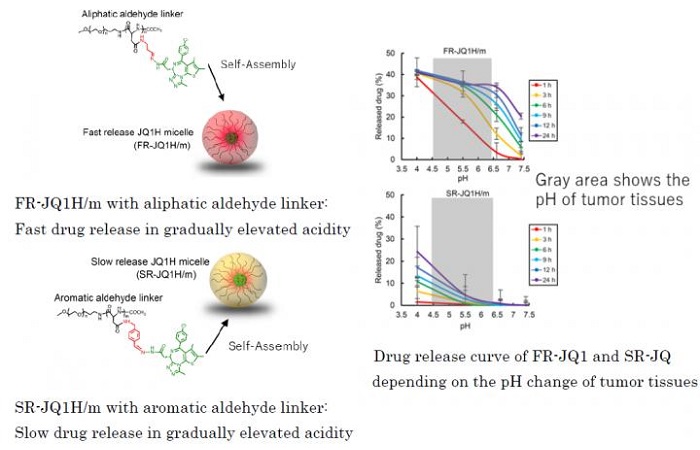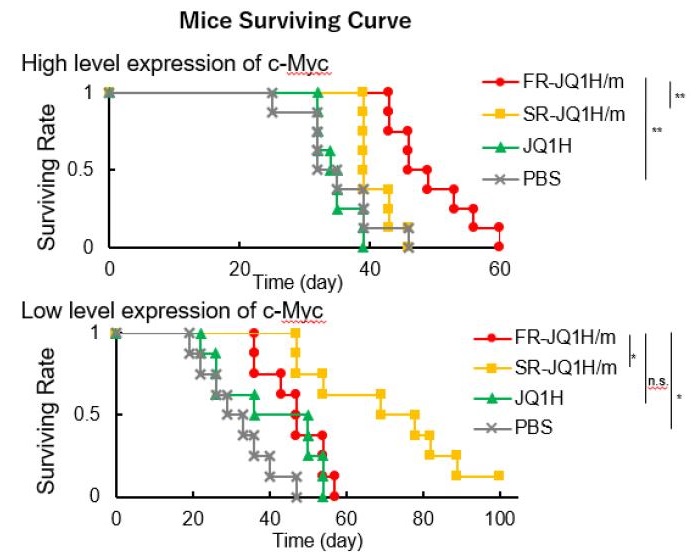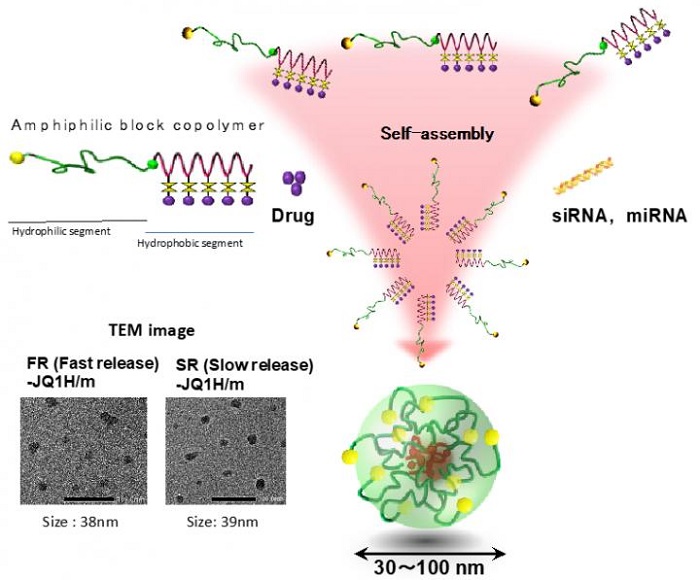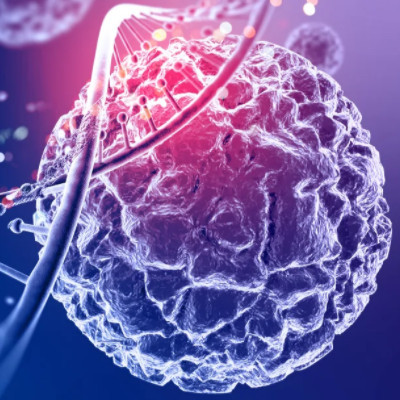It is known that c-Myc is involved in cancer cell proliferation and angiogenesis and changes the cell cycle, suppresses normal cell differentiation, and promotes cancer metastasis. It is a typical proto-oncogene that regulates many genes related to growth factors and is known to be involved in developing of many cancers, such as chromosomal translocation in Burkitt lymphoma.
Therefore, drug discovery research is being conducted worldwide as an anticancer drug targeting this transcription factor that can directly attack cancer stem cells. However, since embryonic lethality occurs in c-Myc knockout mice, c-Myc is considered as an essential gene for living cells, and selective delivery to cancer tissues is an important key to developing its inhibitors.
Besides, c-Myc is also known as a factor necessary for the initial induction of iPS cells. In the future this inhibition can be expected to be applied as a technology that can also be used to suppress iPS cell-derived carcinogenesis.

Fig. 1: Different drug release profile depending on the linker used for block-copolymers of nano-micelles FR-JQ1H/m with aliphatic aldehyde linker: Fast drug release in gradually elevated acidity SR-JQ1H/m with aromatic aldehyde linker: Slow drug release in gradually elevated acidity Drug release curve of FR-JQ1 and SR-JQ depending on the pH change of tumor tissues.
In this study, JQ1H, which is a structural analogue of JQ1H, a typical indirect c-Myc inhibitor, was encapsulated inside functional nano-micelles, and their efficacy was evaluated. JQ1 binds to a bromodomain protein called BRD4, which is involved in the activation of RNA polymerase II regulating the expression of c-Myc, to inhibit this stream strongly.
As a result, the activity of RNA polymerase is weakened and c-Myc expression is down-regulated. Although JQ1 was expected as a promising epigenome drug due to its strong gene expression inhibition, it has an extremely short half-life in vivo due to its fast kidney excretion and rapid clearance after administration. Additionally, JQ1 is almost insoluble in water. These properties of JQ1 became big issues to develop it as an effective drug.
The polymeric nano-micelles developed so far at the Innovation Center of NanoMedicine (iCONM), for anticancer therapy, demonstrated (1) stabilization of encapsulated drugs, (2) suppression of kidney excretion, (3) EPR (selective drug delivery to cancer tissues) mediated tumor accumulation, and (4) drug release based on tumor acidosis. This time, we confirmed good antitumor activity in mice transplanted with tongue cancer, melanoma and pancreatic cancer using JQ1-equipped nano-micelles.

Fig.2: Anti-tumor efficacy of FR-JQ1H/m and SR-JQ1H/m depending on the expression level of c-Myc (IMAGE).
Nano-micelles containing JQ1H leak into the tumor tissue from blood vessels after systemic administration due to the so-called EPR effect. Tumor tissues are rich in lactic acid due to its enhanced glycolysis and is more acidic than normal tissues.
In this work, two types of nano-micelle were prepared; one in which hydrophobic JQ1H were linked to a amphiphilic block polymer composed of hydrophilic polyethylene glycol block and hydrophobic poly-amino acid block using 3-aminopropionaldehyde (aliphatic aldehyde) linker and the other micelle in which JQ1H was linked with polymer via p-aminomethylbenzaldehyde (aromatic aldehyde) linker. An amphiphilic block polymer was synthesized and used as a base material for nano-micelles (Fig. 1).
When it was self-assembled in water to a micellar structure and administered to cancer-bearing mice, the antitumor activity shown in Fig. 2 was achieved. When the linker is an aliphatic aldehyde or when it is an aromatic aldehyde, the release pattern of the drug differs greatly depends on the acidity. The former releases the drug rapidly, and the latter releases the drug slowly.
Therefore, the former nano-medicine was named FR-JQ1H/m and the latter was named SR-JQ1H/m. The antitumor activity of these nano-micelles differ greatly depending on the expression level of c-Myc. While, FR-JQ1H/m is more effective for tumors with high c-Myc expression, SR-JQ1H/m is more effective for tumors with low c-Myc expression.

Polymeric micelles were one of the first polymer self-assemblies reported as a nano-DDS, and are composed of distinct two domains, a drug-loading core and a hydrophilic shell. Amphiphilic block copolymers, containing a hydrophilic block and a hydrophobic block, are firstly revealed to construct those distinct domains in a micelle structure through spontaneous self-assemble as a result of hydrophobic interactions in aqueous. H. Cabral, K. Miyata, K. Osada, K. Kataoka, "Block copolymer micelles in nanomedicine applications".
In the future, we believe that the selection of nano-micelles according to the expression level of biomarkers will be an important step toward the realization of personalized medicine and in-body hospitals.
Read the original article on Bioengineering.
